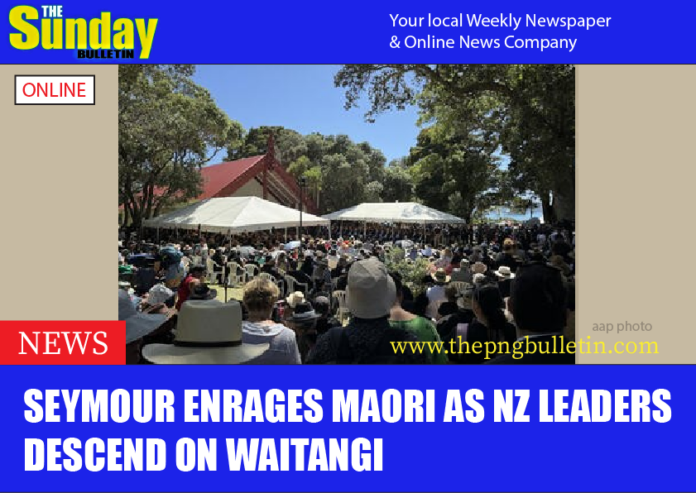AAP: THE row over the role of the Treaty of Waitangi in modern-day New Zealand shows no sign of abating, with protests on the eve of the country’s national day.
Maori women have led a protest on the eve of the country’s national day, as New Zealand’s would-be constitutional revisionist David Seymour delivered an incendiary address at the Waitangi Treaty Grounds.
New Zealand, which turns 185 on Thursday, is reviewing the place of the Treaty of Waitangi in law at Mr Seymour’s urging.
The right-wing ACT party leader hopes to change the legal meaning of New Zealand’s foundational document through the Treaty Principles Bill, currently before parliament.
Mr Seymour argues the treaty should be understood as giving all Kiwi citizens equal rights.
The generally-understood interpretation of the treaty, signed by Maori chiefs and the British Crown in 1840, is it affords Maori specific rights, including over natural resources.
The bill will not become law as ACT’s coalition partners National and NZ First have pledged not to support it any further.
However, its tabling in parliament, along with a six-month public consultation, has generated historic backlash, including tens of thousands of Kiwis marching on parliament last December in the country’s largest-ever protest.
Given his bogeyman status, Mr Seymour’s presence at the Waitangi Treaty Grounds on Wednesday as part of an annual gathering of political leaders was always likely to generate angst.
Many Maori turned their backs and attempted to sing over Mr Seymour’s speech, with someone even taking his microphone away in unfortunate scenes at the birthplace of the modern New Zealand nation.
Mr Seymour played up to his role of bogeyman with a speech attacking his critics and arguing Maori should aspire to more.
“Here are some problems that you can’t turn your back on because the numbers do not lie,” he said.
“Maori home ownership. Maori school attendance. Maori crime victimisation. Maori unemployment. Maori incomes. Maori life expectancy … none of it is getting better.
“If this is what a treaty partnership looks like, how is it working out for Maori?”
The following speaker, Greens representative Teanau Tuiono won laughs from the crowd as he followed Mr Seymour.
“I don’t know how to follow that. The bar is so low i might need a shovel to get lower,” he said.
Deputy Prime Minister Winston Peters – who hands over the baton as deputy to Mr Seymour in May under a power-sharing arrangement – said his NZ First party would not support Mr Seymour’s law but he deserved better treatment.
Mr Peters said the “magic of the marae” where the discussions were heard, included “a tikanga (practice) of respect where people could be heard out”.
In a break to recent practice, Prime Minister Chris Luxon was not at Waitangi for these discussions, opting instead to spend the national day on South Island.
At the same time as the gathering, Mr Luxon was 1000km away in Christchurch, announcing a road upgrade.
Opposition Leader Chris Hipkins attacked Mr Luxon for his Waitangi no-show.
“We should come to listen, and we should come to find the path forward … leadership needs to come from the top and that’s why I’m here and will be here every year that I’m in politics,” he said.
Earlier in the week, New Zealand’s Maori Queen – Nga wai hono i te po – made her first visit to Waitangi as the leader of the Kiingitanga movement.
The 27-year-old, who succeeded Kiingi Tuheitia following his death in August last year, was welcomed onto the Treaty Grounds in a ceremony featuring hundreds of participants in a mighty haka.

